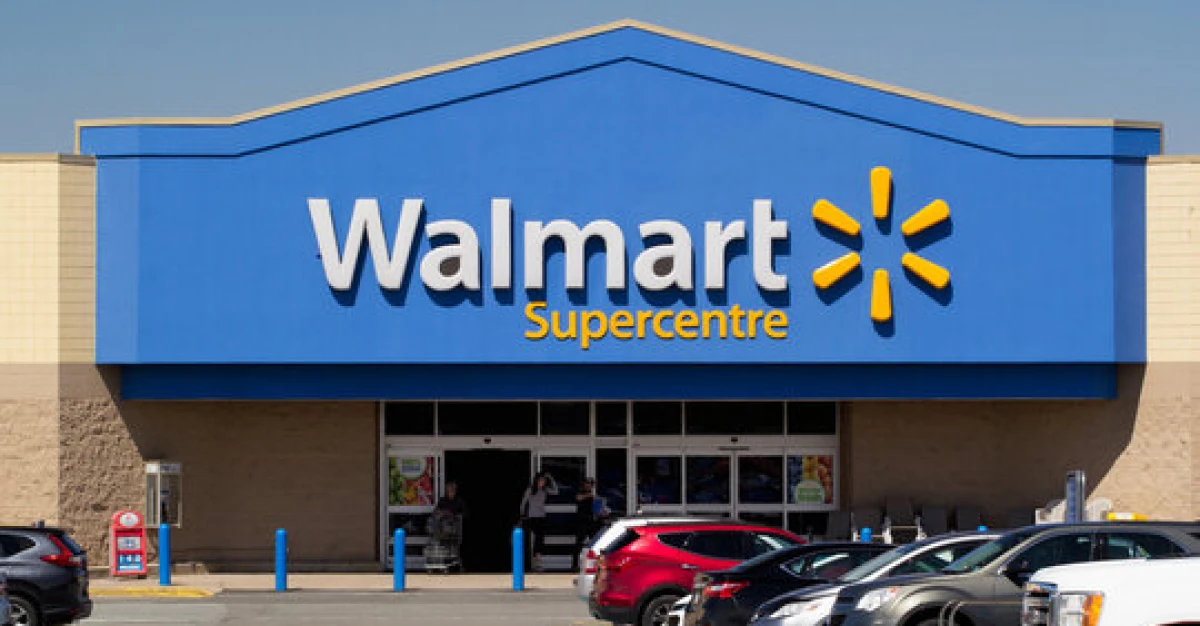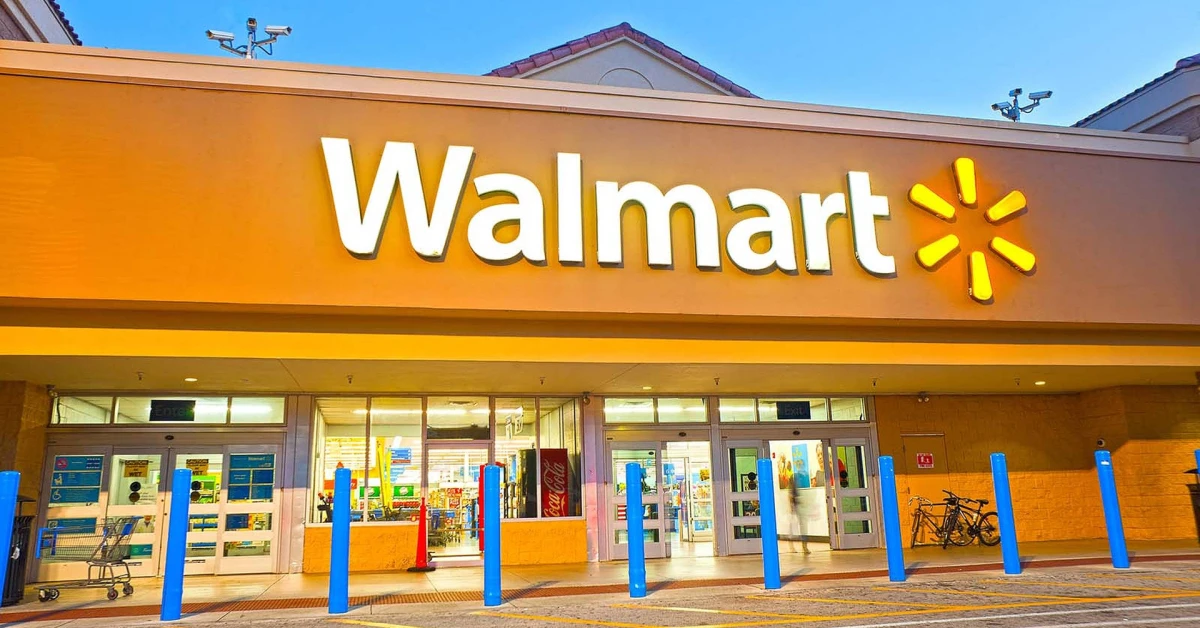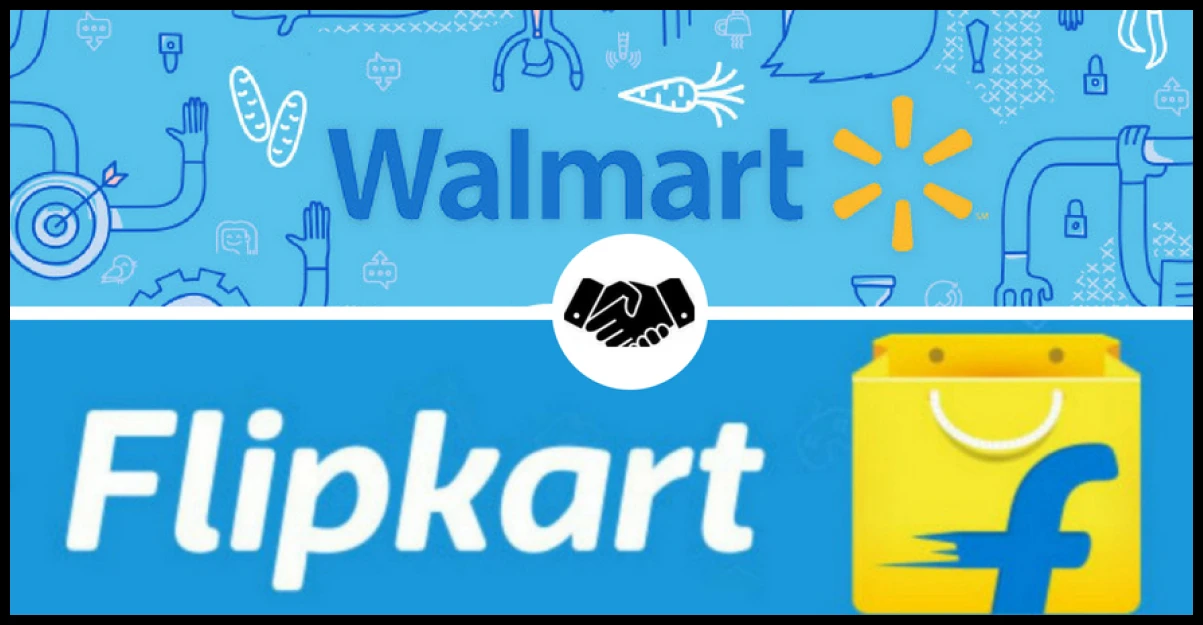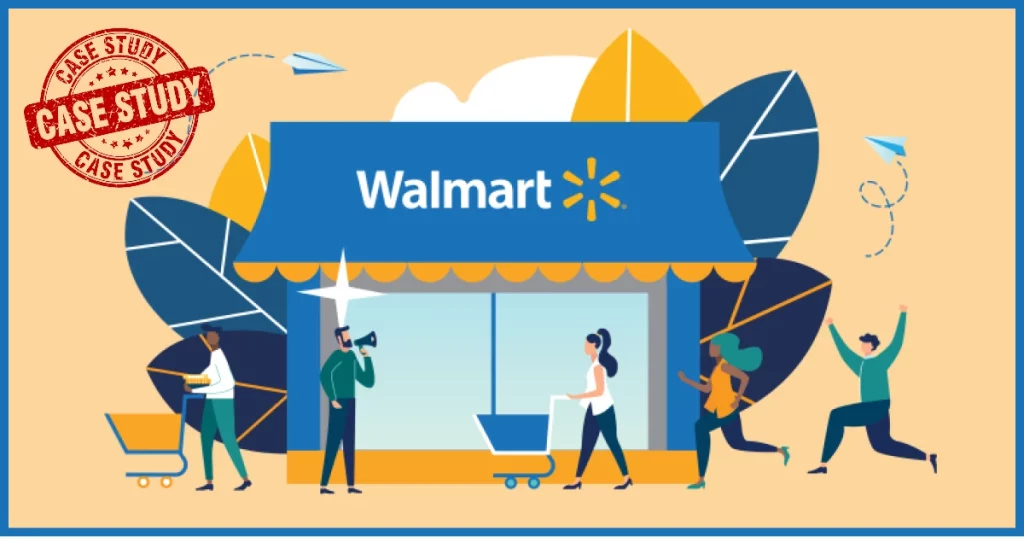Recently, we saw a huge demand for Walmart Case Study from our readers. So here we are presenting your demand for Walmart Case Study in detail.
Walmart is often referred to as the king of the retail world. Reason? Quality goods, lucrative discounts, loyal user base, efficient customer service, and the list goes on! Many retail companies come and go. But Walmart survived for over 62 years!

Have you ever wondered how?
Due to its smart operating strategies! What are those? You may wonder. In the Walmart Case Study, we will unravel those operating strategies, that made Walmart the kind of the retail world.
Stay tuned!
(A) Synopsis: What is Walmart?
Yesterday, Walmart announced a 3-for-1 stock split to boost employee ownership! And this news created a buzz in the market. This left the folks astonished about the smart strategies opted for by Walmart that led to its multiple decade-old grand success.
So, Walmart is this huge American company that was started in 1962 by two brothers, Sam and Bud Walton, in Arkansas. They run lots of stores, like hypermarkets and discount stores, not just in the US but also in other countries.
As of October 2022, Walmart has a whopping 10,586 stores in 24 countries, under various names. They’re a big deal in places like the US, Canada, Mexico, Central America, and even India under the name Flipkart Wholesale.
You know what, Walmart is a big player globally, being the world’s largest company. How was this fact determined? You may wonder. Well, it was determined based on the revenue in 2022. They also announced a massive revenue of $611.3 billion for the fiscal year 2023. With a jaw-dropping 2.2 million employees, it’s the largest private employer worldwide.
The company has an interesting history – starting small in the 1960s and quickly becoming the most profitable US retailer by 1988. It went public on the New York Stock Exchange in 1972 and expanded from the South to coast-to-coast by the early 1990s. We will discuss the history in detail later.
While Walmart has been super successful in some countries, like Canada and the UK, it faced challenges in places like Germany, Japan, South Korea, Brazil, and Argentina. So, it’s been a bit of a rollercoaster, but overall, Walmart is a massive player in the global business game!
(B) Walmart: A Brief Overview
Before diving deeper into the Walmart Case Study, let’s have a brief overview of the company-
| Name of the Company | Walmart Inc. |
| Former Names | Wal-Mart Discount City (1962–1969) Wal-Mart, Inc. (1969–1970) Wal-Mart Stores, Inc. (1970–2018) |
| Type of Company | Public |
| Market Capitalization | $445.81 billion |
| Traded as | NYSE: WMT DJIA component S&P 100 component S&P 500 component |
| Operating Industry | Retail Segment |
| Founded | July, 1962 |
| Founder | Sam Walton, Bud Walton |
| Headquarters | Bentonville (Arkansas, USA) |
| Number of Locations | 10,586 stores worldwide (October 31, 2022) |
| Area Served | Worldwide |
| Products | Food, drinks, groceries, clothing, footwear, beauty products, jewelry, accessories, furniture, decor, bedding, bath, electronics, appliances, housewares, toys, games, books, movies, musical instruments, pet supplies, baby products, hygiene products, health products, school and office supplies, tools, gifts, garden center, pharmacy, photo center, sporting goods, and auto center |
| Services | Walmart-2-Walmart |
| Competitors | Target, Amazon, Home Depot, Kroger, Carrefour, Alibaba, Costco |
Note: Do you know Target is one of the strong competitors of Walmart? If you are curious to delve into their comparative analysis, then visit the article “Walmart vs Target: Which one is better for public investors?”
(C) Walmart Case Study: History & Timeline
Let me take you back to 1945 when Sam Walton, a young guy fresh from World War II, had this grand idea of building a retail empire. Fast forward to 1962, he kicks things off by opening the very first Walmart store in Rogers, Arkansas.
His mission? Simple – provide a bunch of stuff at affordable prices and treat customers like VIPs.
Guess what?
That mission stuck around. Walmart’s all about those wallet-friendly prices, and that’s how it’s been ruling the retail scene for ages, becoming a name you know wherever you go.
But hold up, it’s not just about low prices. Walmart’s like a treasure trove – groceries, electronics, clothes, you name it, they got it. And this winning combo of cheap goodies and a massive selection? That’s the secret sauce that’s turned Walmart into this retail giant we all know and, let’s be real, probably visit regularly.
Look at the history of Walmart in the following table-
| Year | Milestone |
| 1962 | Founded by Sam and Bud Walton in Rogers, Arkansas |
| 1969 | Incorporated under Delaware General Corporation Law |
| 1972 | Listed on the New York Stock Exchange |
| 1988 | Became the most profitable retailer in the US. |
| 1989 | Largest retailer in terms of revenue |
| 1990 | Expanded to the Northeastern US. The first California outlet was opened in Lancaster. |
| 2002 | Walmart enters the grocery market. |
| 2005 | Retail rose to multinational status and took various environmental initiatives. |
| 2006 | Announced a joint venture with Bharti Enterprises to operate in India. |
| 2008 | Launched a new logo and a new slogan “Save money, live better” |
| 2012 | Walmart launched Goodies (a mail subscription service) |
| 2015 | Became the biggest US commercial producer of solar power with 142 MW capacity & 17 energy storage projects. |
| 2018 | Acquired a 77% majority stake in Flipkart (an Indian e-commerce company) |
| 2019 | Stopped selling cigarettes, tobacco products, live fish, and aquatic plants. |
| 2020 | Launched Carrier Pickup, allowing the customers to schedule returns. |
| 2022 | Walmart Brazil’s shareholdings divested to Carrefour |
| 2023 | Announced FY2023 total revenue of $611.3 billion |
| 2024 (Present) | Largest private employer with 2.2 million employees |
That’s a legendary history! Isn’t it? Well, this is all about the details of our Walmart case study. Hold on. The question is still brewing- How did Walmart become the retail giant?
We will look into it. But, before that, you need to understand its business model and revenue model.
(D) Walmart Business Model
When you step into Walmart, you’re diving into a world where they keep prices low every day, making things affordable for you. It’s not just about good prices – it’s like a shopping wonderland with everything you can think of, from groceries to gadgets, all in one spot.
The secret sauce? They’re really good at managing how things get from the supplier to the shelves, keeping everything running smoothly.
Plus, because Walmart is so big, they can get awesome deals and pass the savings on to you. They’re all about using smart technology to make your shopping experience top-notch, and they care about making sure you leave happy.
So, when you’re at Walmart, it’s not just a store – it’s a place designed to give you great prices, lots of choices, and a pleasant time shopping.
Let’s look at Walmart’s business model-
| Working Strategies | Particulars | Details |
| Everyday Low Prices (EDLP) | Key Principle | Walmart’s foundational strategy revolves around offering Everyday Low Prices (EDLP). This means the company commits to providing consistently low prices on its products, aiming to attract and retain customers through affordability. |
| Supplier Relationships | Walmart works closely with suppliers to negotiate cost-efficient terms, allowing them to pass on the savings to customers. The company is renowned for its formidable bargaining power with suppliers. | |
| Wide Product Selection | Diversity of Offerings | Walmart prides itself on an extensive and diverse product assortment. From groceries and household items to electronics, clothing, and more, the goal is to be a one-stop destination for consumers’ various needs. |
| Private Label Brands | Walmart strategically incorporates private-label or store-brand products. This gives them greater control over pricing and margins, contributing to the overall affordability proposition. | |
| Supply Chain Efficiency | Advanced Logistics | Walmart is a pioneer in implementing advanced supply chain and logistics management systems. The company’s distribution centers are strategically located for efficient product flow, ensuring a streamlined process from manufacturer to store shelves. |
| Inventory Management | Walmart utilizes cutting-edge technology to manage inventory effectively. This includes systems like RFID (Radio-Frequency Identification) to track merchandise throughout the supply chain, reducing stockouts and overstock situations. | |
| Technology Integration | Data Analytics | Walmart leverages data analytics to understand consumer behavior, optimize inventory levels, and personalize marketing strategies. This data-driven approach enhances operational efficiency and customer satisfaction. |
| E-commerce Focus | In response to changing consumer preferences, Walmart has invested significantly in e-commerce. The integration of online and offline channels allows customers to shop seamlessly, emphasizing convenience. | |
| Customer-Centric Approach | Service and Experience | Beyond low prices, Walmart emphasizes customer service and shopping experience. The company invests in employee training to ensure courteous and helpful staff, contributing to a positive in-store experience. |
| Adaptation to Consumer Trends | Walmart continually adapts its offerings to align with evolving consumer trends. This flexibility allows the company to stay relevant and meet the changing demands of the market. | |
| Global Expansion | Market Penetration | Walmart has expanded its footprint globally, operating in multiple countries under various formats, including supercenters, discount stores, and wholesale clubs. |
| Adaptation to Local Markets | While maintaining a consistent core business model, Walmart adapts its strategies to suit the specific needs and preferences of diverse international markets. |
In essence, the Walmart business model is a comprehensive strategy that combines cost leadership, operational efficiency, technological innovation, and customer-centricity to create a retail powerhouse with a global reach.
(E) Three Crucial Segments of Walmart

Here comes another important part of Walmart, its three critical pillars-
(E.1) Walmart US Segment: Dominance in the Domestic Market
Under the umbrella of the Walmart U.S. segment lies the retail giant’s stronghold in the United States. With a colossal total revenue of $387.5 billion reported in February 2023, this segment encompasses the extensive network of Walmart and Sam’s Club stores across the nation.
Offering an unparalleled variety of products, from groceries to electronics, this segment plays a pivotal role in shaping Walmart’s identity as a go-to destination for millions of American consumers. The sheer scale of revenue from this segment underscores Walmart’s unrivaled dominance in the U.S. retail landscape.
(E.2) Walmart International Segment: Global Reach and Diversification
Walmart’s global influence extends through the Walmart International segment, operating in 24 countries and boasting a network of 10,586 stores and clubs as of October 2022.
While facing challenges in some markets, this segment has showcased resilience, with successful operations in key regions such as Canada, the United Kingdom (ASDA), Mexico, and Central America. The diverse geographical presence reflects Walmart’s commitment to meeting the diverse needs of consumers worldwide.
This segment’s contribution to the overall revenue highlights Walmart’s strategic approach to global expansion and market diversification.
(E.3) Walmart US E-Commerce Segment: Navigating the Digital Frontier
As consumer preferences shift in the digital era, Walmart has strategically positioned itself in the online retail space through the Walmart U.S. eCommerce segment. With a notable total eCommerce sales figure of $118 billion reported in February 2023, this segment represents Walmart’s foray into the digital marketplace.
Emphasizing the company’s adaptability, the eCommerce segment has experienced significant growth, catering to the evolving needs of tech-savvy consumers. This dynamic approach underscores Walmart’s commitment to embracing technological trends and ensuring a seamless shopping experience for customers in the ever-expanding digital frontier.
(F) Walmart Revenue Model: How does Walmart make money?
Walmart’s revenue model combines numerous aspects like traditional retail sales, online commerce, membership fees, international operations, private labels, financial services, and real estate management.
Before diving into the Walmart revenue model, let’s quickly look at its financials-
| Financial Aspects (FY23) | Data |
| Market Capitalization | $445.81 billion |
| Revenue Earned | $611.3 billion |
| Operating Income | $20.4 billion |
| Net Income | $11.29 billion |
| Total Assets | $243.45 billion |
| Total Equity | $83.754 billion |
| Expenses | $613.466 billion |
| Profit | $155.045 billion |
Coming to Walmart revenue model, we will break it down into the following points-
(F.1) Retail Sales
The primary source of revenue for Walmart is its extensive network of physical stores under the Walmart U.S. and Walmart International segments. These stores, including Walmart and Sam’s Club, offer a vast array of products, ranging from groceries and electronics to clothing and home goods. Revenue is generated through the sale of these products at competitive prices, aligning with Walmart’s commitment to everyday low prices (EDLP).
(F.2) E-Commerce Sales
With the growing influence of online retail, Walmart has strategically expanded its presence in the digital space. The Walmart U.S. eCommerce segment contributes significantly to revenue through online sales. Customers can purchase products through the Walmart website or mobile app, expanding Walmart’s reach and catering to consumers who prefer the convenience of online shopping.
(F.3) Membership Fees
Sam’s Club, a membership-based retail warehouse club under the Walmart umbrella, generates revenue through membership fees. Customers pay an annual fee to access exclusive deals, bulk purchasing options, and other members-only benefits.
(F.4) Global Operations
The Walmart International segment contributes to revenue through its diverse operations in 24 countries. Revenue is generated from retail sales in these international markets, where Walmart adapts its strategy to suit local consumer preferences and market dynamics.
(F.5) Private Labels and Brands
Walmart has introduced private labels and exclusive brands, including Great Value and Mainstays. These products, often sold at lower prices compared to national brands, contribute to overall revenue. Additionally, Walmart earns revenue through partnerships and collaborations with other brands, both in-store and online.
(F.6) Financial Services
Walmart provides various financial services, such as money transfers, check cashing, and prepaid debit cards, through its Walmart MoneyCenter. While not the primary revenue stream, these services contribute to the overall financial ecosystem within Walmart stores.
(F.7) Retail Estate & Leasing
Walmart owns a significant amount of real estate, including its stores and distribution centers. The company may generate additional revenue by leasing excess space in its properties to third-party businesses.
In essence, Walmart’s revenue model is multifaceted, reflecting its diverse operations. This diversified approach enables Walmart to navigate various market conditions and consumer preferences, solidifying its position as one of the world’s largest and most successful retail giants.
(G) How did Walmart become the retail giant?

Here we will have a quick recap of whatever you read till now. Walmart’s ascent to retail giant status can be attributed to several key factors, each playing a crucial role in its success. Let’s break them down one by one-
(G.1) Foundational Principles
Walmart was founded on the principles of offering a wide variety of products at low prices while treating customers with respect and dignity. From its inception in 1962, founder Sam Walton emphasized the importance of serving the needs of the average American family by providing affordable goods and exceptional customer service.
(G.2) EDLP (Everyday Low Prices)
Walmart revolutionized the retail industry by adopting the EDLP strategy. Rather than relying on periodic sales and promotions, Walmart committed to maintaining consistently low prices across its products. This approach not only attracted budget-conscious consumers but also instilled trust and loyalty among shoppers who knew they could rely on Walmart for affordability.
(G.3) Supply Chain Efficiency
Walmart invested heavily in optimizing its supply chain and logistics operations. Through innovative technologies and streamlined processes, Walmart was able to reduce costs, minimize inventory holding times, and improve product availability. This efficiency allowed Walmart to pass on savings to customers while maintaining healthy profit margins.
(G.4) Scale and Expansion
Walmart’s aggressive expansion strategy played a pivotal role in its growth trajectory. The company rapidly expanded its footprint across the United States, opening new stores and acquiring existing chains. This expansion was not limited to domestic markets; Walmart also ventured into international territories, establishing a global presence in multiple countries.
(G.5) Diverse Product Assortment
Walmart’s extensive product assortment became a hallmark of its success. Beyond traditional retail categories like groceries and apparel, Walmart diversified its offerings to include electronics, home goods, automotive supplies, and more. This breadth of selection appealed to a wide range of consumers, further solidifying Walmart’s position as a one-stop destination for shopping needs.
(G.6) Technological Innovation
Walmart embraced technology as a catalyst for growth and efficiency. The company invested in advanced systems for inventory management, point-of-sale operations, and data analytics. These technological advancements not only enhanced operational efficiency but also enabled Walmart to better understand consumer behavior and preferences, facilitating targeted marketing and product assortment strategies.
(G.7) Customer-Centric Approach
Throughout its evolution, Walmart maintained a steadfast commitment to customer satisfaction. Whether through its price match guarantee, hassle-free return policy, or friendly in-store experience, Walmart prioritized the needs and preferences of its customers. This customer-centric approach fostered strong brand loyalty and repeat business.
Thus, Walmart’s journey to retail giant status was propelled by a combination of visionary leadership, innovative strategies, operational excellence, and unwavering dedication to customer value. By staying true to its core principles while continuously adapting to changing market dynamics, Walmart has cemented its place as one of the world’s most influential and successful retail organizations.
(H) Flipkart Acquisition: Walmart’s Strategic Move

In 2018, Walmart made a groundbreaking move by acquiring Flipkart, India’s largest e-commerce platform. This strategic move marked Walmart’s entry into the rapidly growing Indian retail market, positioning itself for a piece of the action in one of the world’s fastest-growing economies.
The acquisition came with a hefty price tag of $16 billion, granting Walmart an impressive 77% stake in Flipkart, solidifying it as the largest-ever deal in the Indian e-commerce sector.
Let’s look at some of the significant consequences of the Flipkart acquisition-
- Market Presence Amplified: Walmart’s acquisition allowed it to step into the thriving Indian e-commerce market, projected to become one of the largest globally. Flipkart, boasting over 200 million registered users, presented Walmart with a golden ticket to tap into a diverse array of products and a vast customer base.
- Technological Upgrade: Leveraging Flipkart’s technological prowess, Walmart fortified its online capabilities to stand tall among major e-commerce players. Flipkart’s innovative features like mobile payments, product recommendations, and data analytics became valuable tools for Walmart, enhancing the overall customer experience.
- Logistics Overhaul: Flipkart’s robust supply chain and logistics infrastructure in India became Walmart’s ace in the delivery game. The acquisition empowered Walmart to elevate its delivery and fulfillment capabilities, with Flipkart’s expertise in last-mile delivery and supply chain automation proving to be invaluable.
- Amazon Rivalry: Walmart’s move was not just a business strategy; it was a direct response to Amazon’s rapid expansion in India. The acquisition of Flipkart strategically positioned Walmart to challenge Amazon’s dominance in the Indian e-commerce market, intensifying the competition between these retail giants.
- Financial Boost: The Flipkart acquisition significantly contributed to Walmart’s financial performance. In the fiscal year 2021, Walmart’s international net sales saw a notable 1.3% increase, fueled in part by robust growth in India, showcasing the financial gains resulting from this strategic move.
As of 2021, Walmart asserted a 9.3% share of the global retail market, outpacing Amazon’s 2.3% and Costco’s 1.6%. This not only underscores Walmart’s dominance but also highlights the impact of strategic acquisitions in fortifying its global retail presence.
That’s how Walmart’s acquisition of Flipkart was more than just a business deal. It was an efficient strategic move that unlocked new opportunities, transformed technological capabilities, and propelled Walmart into the vibrant and competitive landscape of Indian e-commerce.
(I) Marketing Strategies: An Integral Part of Walmart Case Study

Creating a winning marketing plan is key for survival in today’s market, and Walmart has a unique strategy to make its mark. Walmart plays the game of business marketing with a powerful approach called market penetration. It’s like diving in, offering you, the customer, not just low prices but seriously competitive ones.
This isn’t just a random strategy; it’s part of Walmart’s cost leadership game plan, and let me tell you, it’s working like a charm, raking in massive profits.
The following table describes some of the most effective marketing strategies of Walmart-
| Marketing Strategies | Particulars | Details |
| Market Penetration Mastery | Strategic Dive-In | Walmart doesn’t just wade into the market; it dives in with market penetration. This approach is all about capturing your attention by offering not just low prices but seriously competitive ones. |
| Cost Leadership Game | Walmart’s cost leadership strategy isn’t just a game-changer; it’s a profit magnet. By providing low prices and treating every customer like royalty, they’ve found the sweet spot for business success. | |
| Customer-Centric Approach | Royal Treatment to Customers | At Walmart, you’re not just a customer; you’re the king or queen of the market. The company’s commitment to treating customers with utmost respect builds a strong bond that goes beyond just transactions. |
| Four Pillars of Choice | According to Walmart, your choice of retailer is guided by four pillars: price, access, experience, and assortment. It’s about more than just cost; it’s about making your shopping journey enjoyable and convenient. | |
| Local Sourcing Brilliance | Community Benefits | Walmart’s strategy involves buying bulk from local manufacturers and selling in smaller quantities. It’s not just a business move; it’s a community win. More products from local manufacturers mean more jobs and a reduction in unemployment rates. |
| Quality at the Core | Walmart’s commitment extends beyond quantity. They believe in offering top-quality products at prices that make sense for you, maintaining a delicate balance between affordability and excellence. | |
| Global Impact through Local Choices | Job Creation | Walmart’s local sourcing isn’t just about products; it’s about creating jobs. By supporting local manufacturers, they contribute to economic growth and reduce unemployment. |
| Customer-Centric Sustainability | This strategy isn’t just about business; it’s about creating a sustainable relationship with customers. Quality, affordability, and community impact form the pillars of Walmart’s global-local approach. |
So, what’s their secret sauce? Walmart treats every customer like royalty, making you feel like the king or queen of the market.
According to Walmart, four things guide your decision on where to shop: price, access, experience, and assortment. It’s not just about what you pay; it’s about how easy it is to get what you want, the overall shopping experience, and the variety of stuff they offer. It’s like Walmart saying, “We’ve got it all, and we’ve got it at a great price.”
But here’s a cool twist in their strategy: Walmart goes local.
Yep, they buy heaps of stuff from local manufacturers all at once and then sell it to you in smaller quantities. It’s a win-win situation. By buying local, they’re not just bagging good deals; they’re also creating jobs and helping tackle unemployment. And hey, it’s not just about quantity; it’s about quality too.
Walmart believes in offering you top-notch products at prices that won’t leave your wallet weeping.
So, there you have it – Walmart’s marketing magic is a blend of rock-bottom prices, treating you like royalty, giving you a shopping experience to remember, and making sure there’s a bit of everything for everyone.
It’s not just a shopping trip; it’s a journey where you’re not just a customer; you’re the ruler of the market! That’s what Walmart claims…
(J) Wrapping Up the Walmart Case Study

Here comes the final part of the Walmart case study. Here you went through Walmart’s journey to retail giant status. All of it is a testament to visionary leadership, strategic adaptability, and customer-centric innovation.
From its foundation on the principles of everyday low prices to aggressive global expansion and astute acquisitions like Flipkart, Walmart has continuously evolved. The company’s commitment to technological advancements, supply chain efficiency, and community engagement sets it apart.
As of 2021, with a 9.3% share of the global retail market, Walmart’s success underscores the significance of a holistic approach – one that prioritizes affordability, diversity, and a deep understanding of evolving market dynamics in shaping the retail landscape.

